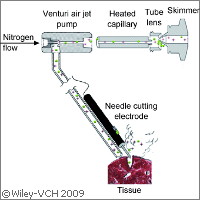New technique could spare cancer patients from further surgery
EU-funded researchers have developed a technique that could allow surgeons to distinguish between cancerous and healthy tissue in real time as they carry out operations. The novel technique, which is described in an article in the journal Angewandte Chemie International Edition, could spare cancer patients from having to undergo a second round of surgery to remove tumour tissue that was missed during the first operation. EU support for the work came from the DESI_JEDI-IMAGING ('Development of mass spectrometric techniques for three-dimensional imaging and in-vivo analysis of biological tissues') project, which received a EUR 1.75 million grant from the European Research Council (ERC) under the Seventh Framework Programme (FP7). Surgery is a common tool in cancer treatment. Tissue removed during an operation is sent to the laboratory for analysis to ensure that all of the diseased tissue has been removed. Currently, it takes several days to examine the tissue; if it turns out that some diseased tissue has been left in the patient, he or she may require a second operation. The starting point of the new technique is electrosurgery. In electrosurgery, the conventional scalpel is replaced with an electroscalpel, in which a high-frequency electrical current is used to cut through and remove tissue. An advantage of electrosurgery is that while a cut is being made, blood vessels are closed off, thereby avoiding excessive bleeding. As the surgeon works, the treated tissue becomes extremely hot and is partially vaporised. In addition, the electrical current triggers the production of electrically charged molecules. Different types of tissue have different molecular profiles, and, crucially, the molecular profile of cancerous tissue looks very different to that of healthy tissue. In this latest study, German and Hungarian researchers fitted a conventional electroscalpel with a special pump that sucks up the vaporised molecules and sends them to a mass spectrometer. Here, the molecular profile of the tissue being cut is analysed and the information is provided to the surgeon in real time. The researchers have dubbed their new technique REIMS (rapid evaporation ionisation mass spectrometry). 'Tissue analysis with REIMS, including data analysis, requires only fractions of a second,' commented Dr Zoltán Takáts of Justus Liebig University in Germany. 'During an operation, the surgeon thus received virtually real-time information about the nature of the tissue as he was cutting it.' Furthermore, the system was able to tell the surgeon whether the cancer was at an early or advanced stage. 'The presented results serve as a basis for future development of surgical methods guided by mass spectrometry,' the researchers write. 'REIMS allows rapid analysis of vital and processed tissues and real-time identification of tissue features during surgery.' Although the system has not yet been tested on humans, the researchers point out that all the experiments were carried out under the conditions required for human surgical facilities. They are therefore optimistic that the new technique could be easily transferred to the operating theatre.
Countries
Germany, Hungary



